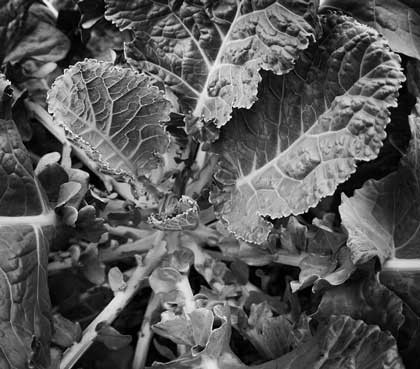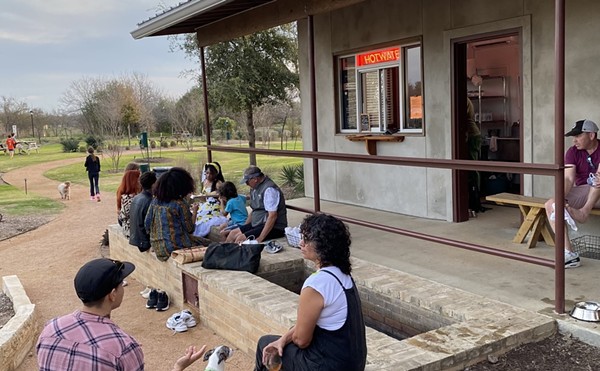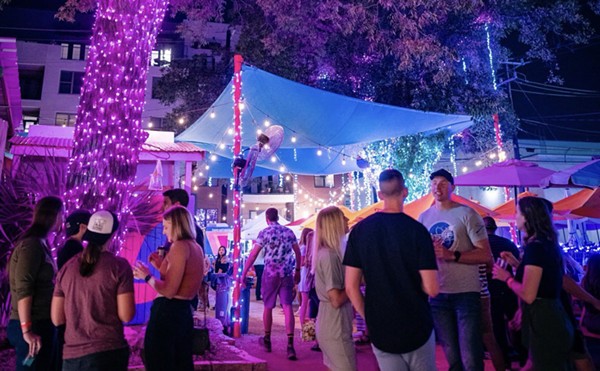With help from friends, Jim Keller seeds his dream garden
Oh, how the afternoon sun oppresses a plant. Delicate squash leaves collapse into a drooping faint, green-bean blossoms drop their chins like napping schoolchildren, and even the heartiest tomatoes seem to squint, the bloom on their cheeks growing rosier by the minute.
| Deep-dusky-green kale flourishes in Jim Keller’s fledgling garden. Friend and neighbor Mary Nethry is helping Keller build a rowdy version of a French Intensive garden to supply fruit and vegetables for his kitchen. |
Not so the monster-sized greens packed into the slim bed under photographer Jim Keller’s bay window. Their firm leaves stand up angrily to the heat, as if daring one to come pluck them: Attack of the Killer Kale! Nearby, a watermelon vine’s pale runners wind past a pear sapling and a fig tree, and appear to be wending for the garden gate. In a week or so there will be champanelle grapes — so tart they’ll make your whole body pucker — and brussels sprouts. Some of these plants, though, are not like the others: Lantana makes a strange bedfellow for the likes of nasturtium and basil.
“I’m not sure the lantana’s going to remain in the garden, as I can’t eat the blooms,” says Keller. “Now, the firebush qualifies as food because it feeds the butterflies and hummingbirds.” A cedar elm is permitted to stay because it provides shade; the fate of a few small aloe plants, remnants of a xeriscaped garden, remains undetermined.
These changes are part of what will soon be Keller’s potager, which he is creating in collaboration with local garden designer Mary Nethry, a family friend and neighbor. When the garden is complete, it will nearly surround the house, with the beds in front, three large raised beds in the back, and banana trees lining the drive.
“He asked for an eccentric gentleman’s kitchen garden,” says Nethry. “More Zen than Victorian,” adds Keller.
Traditionally, a kitchen garden is used to raise just enough produce for one’s household, and is planted as close to the kitchen as possible, so that the cook can pick the flowers, vegetables, herbs, and fruit as needed for the next meal. “I love food,” says Keller, “and there’s really no produce better than what you walk out your back door to collect.”
Keller also asked that his vegetable garden be pretty. “You don’t often see an appealing garden that is a food garden,” he says. “It’s a motif that is underexplored — vegetables are not presented as art.”
Nethry worked with local architect Dick Mycue to incorporate drawings of the garden with planned additions to Keller’s house, including a third-story sunroom with a view of the raised beds. At the back of the garden, Mycue has added a covered porch. Open on three sides, it will center on a fireplace, based on one Keller’s grandfather had on the family ranch, the firebox of which extends ingeniously onto the hearth, so that you can pull the burning logs onto the porch for cooking and the chimney will continue to draw smoke. A curved hearth seat will face the garden, and a tall overmantel should keep South Alamo traffic noise from wafting into the garden.
Although traditional kitchen gardens — which hearken back to medieval monasteries — are formal by design, Nethry has intentionally avoided rows and grids. “I adore symmetry,” she laughs, explaining that she came to gardening in her mother’s ordered vegetable plots. Yet, a heated debate over whether vegetables should march rank-and-file inspired Keller’s asymmetrical garden. “Jim appreciates symmetry, but he didn’t want plants lined up like soldiers,” says Nethry.
Instead, Nethry will combine companionable vegetables, flowers, and herbs together in a slightly untamed version of the French Intensive garden, in which vegetables that mature quickly, such as spinach and mustard, are planted alongside slow growers like pepper and eggplant. When one plant is harvested, another is waiting in seed trays, ready to be planted in its place, so that even a tiny kitchen garden can produce a high yield. Surprisingly, French Intensive gardening is also less taxing on the soil than single-crop gardens. “As you rotate, the garden never looks the same; there’s no pattern,” says Nethry. “We’ll intersperse edible flowers and herbs. It’s wild-looking, but it also helps attract beneficial insects.”
It will be months before there is anything to harvest from the main garden beds, but Keller is already anticipating the bounty. Once a month, he hosts a dinner party, at which guests sample dishes — some as rarified as pecan-fattened squirrel in mustard sauce — at an 8-foot, sky-blue, round table, which he built and outfitted with a giant lazy Susan.
“The garden is just taking those dinners to another level,” says Keller. “It feels like we, the revelers, are right in the middle of a kind of sustainable utopia, even if it’s just for one Sunday.”
Sustainability is important to Keller, who takes a philosophical view of the garden, even as he approaches his first vegetable beds. “I want to promote urban kitchen gardens,” he says. “People have lost a sense of mastery in producing the things we need to live. Most people don’t know to nearly the degree of our forefathers how to make things with their own hands.”
Keller and Nethry are still exploring ways to spread their gospel of gardening. Ideas as wildly diverse as the garden itself spring up amid discussions of compost and drainage, everything from planting fruit at kids-eye level to inspire the youngsters, to an organic salon that incorporates yoga, to an outdoor movie theater. “I don’t know where it’s going to go,” Keller confesses. “I’m interested in expanding the practice of gardening — I don’t care what form that takes. I’m just trying to stay open. I’m sure I’ll be surprised a year from now who’s out there with me tending the garden.”


















